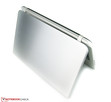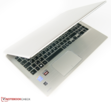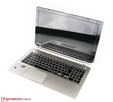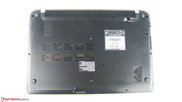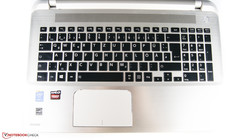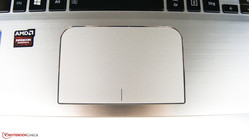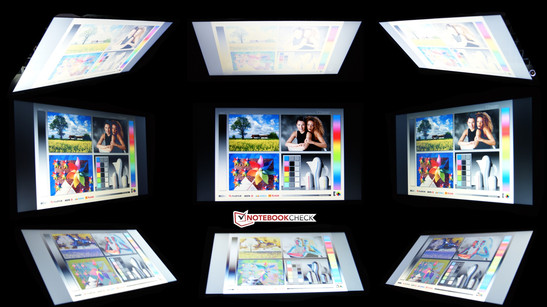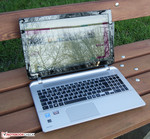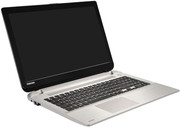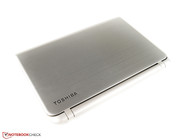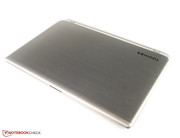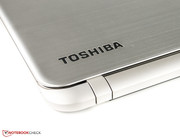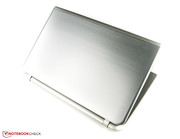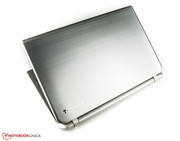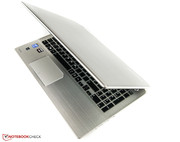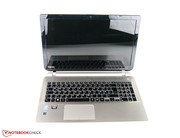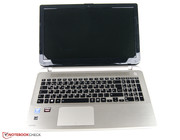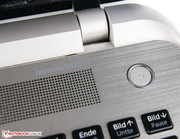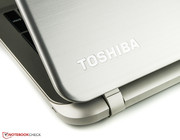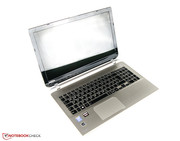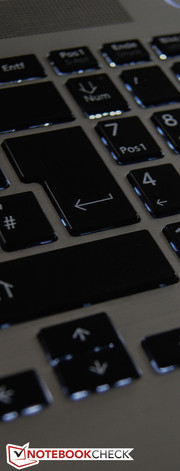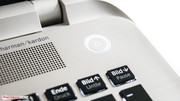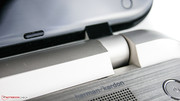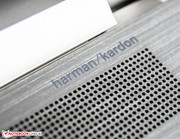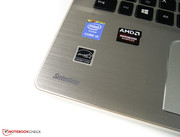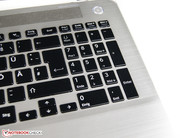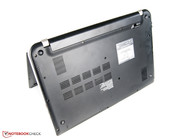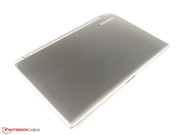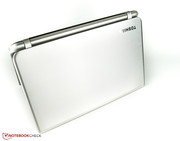Toshiba Satellite S50-B-12U Notebook Review

For the original German review, see here.
Streamlined and ready to be picked up. Toshiba's S50-B-12U is a 15.6-inch multimedia notebook that boasts of good application performance, even with its thin case and lightweight body. The device's height measures just 2 cm, and it weighs only 2 kg (~4.4 lbs). The performance is generated by an Intel Core i5-4210U, 8 GB of working memory, a 750 GB hard drive, and a dedicated AMD Radeon R7 M260 graphics card. The whole configuration is on the market for about 700 Euros (~$846).
The Toshiba S50 has to fight its way through a swarm of notebooks to be noticed. To position the device relative to its competitors, we'll compare it firstly to the Acer Aspire E5-571G-536E, as the Acer computer is also equipped with an Intel Core i5-4210U. However, rather than an AMD card, the Acer notebook has an Nvidia GeForce 840M at its command, and its Full HD display also has a higher resolution. Like our test device, a further competitor is also manufactured by Toshiba -- the Satellite L50-B-182. The L50-B-182 is outfitted with the same graphics unit as our S50-B-12U, but it has a more potent Intel Core i7-4500U and a high-quality IPS panel. Since its release, the L50's price has fallen below the 800-Euro mark (~$967).
Case
The Toshiba glides onto the scene with a simple, elegant, brushed aluminum look. The display lid is constructed of aluminum, while the rest of the case is made of plastic. The device's texture isn't the only thing that pleases the eyes -- the height of just about 2 cm is also alluring. At a low weight of 2 kg (~4.4 lbs), the 15.6-inch notebook is easy to transport. The display is held in place with two little hinges. The hinges don't appear to be particularly stable, and it doesn't take much to make the display bounce. In terms of manufacturing quality, there aren't any conspicuous problems. Glancing over the computer with the naked eye, we can say that some parts of the case could fit together more perfectly. The removable battery is secured by two screws on the bottom side of the device. Any other maintenance work requires the base plate / base unit to be partially dismantled.
Connectivity
Unfortunately, only two of the three USB ports are USB 3.0. Overall, the Satellite S50's range of connections is rather limited. Toshiba also installed an Ethernet port and an HDMI output in their notebook -- and that's it. The positioning of the ports, however, is quite smart. The Ethernet port and one USB connection are located on the left-hand side towards the back, which is a good spot for external devices that will remain plugged in for longer periods. The rest of the ports are situated near the front of the right-hand side, where they can be accessed quickly and easily.
Communication
To establish connections with wireless networks, Toshiba installed an Intel Dual Band Wireless-AC 3160 module. In order to simulate a true-to-life scenario, the author of this review recorded the system's average download rate in his personal test setup. In the first test, our Satellite S50 sat one floor above the router. We also ran this test on an Apple MacBook Pro Retina 13 (Late 2013) for comparison purposes. The MacBook is outfitted with a Broadcom 802.11 ac module. After a series of automatic downloads, the Toshiba S50's download rate settled at almost 4.6 MB/s. At 7.7 MB/s, the MacBook's throughput was considerably higher. When both devices were relocated to the same floor as the router, the two obtained similar results.
Accessories
Besides a manual and various other brochures, our test device doesn't come accompanied by any accessories. The manufacturer's website doesn't list any special accessories for the notebook either -- just cases and power supplies.
Maintenance
Unfortunately, there are no maintenance hatches on the underside of this device. Even the battery has to be unscrewed. Further access to the inner workings of the S50 series can only be achieved by removing the base plate. The manufacturer doesn't include any instructions here.
Warranty
In Germany, the Satellite S50 comes with a 24-month warranty with pick-up service. Further service and warranty options are available on the Toshiba website. The list includes a data recovery service, a warranty extension to three years, and a “no matter what happens” warranty.
Input Devices
Keyboard
The black chiclet keyboard lacks appeal, unfortunately. The flat keys have short but varying travel lengths. Depending on the section of the keyboard, the click points are slightly different. The space bar is especially problematic here. We almost wonder whether our test device might be defective. Some of the special keys are a little on the narrow side, but this isn't a big problem. Users who expect to type on this device for long periods will be better off connecting an external keyboard. On a positive note, the keyboard possesses a small but full number pad, and the keys are backlit with sufficiently bright light. The lighting is activated when a key is hit and can't be turned on and off with an independent key. The click sound produced by the keys during typing is pleasantly quiet.
Touchpad
The touchpad to the south of the keyboard is amply sized. The slightly roughened surface makes it possible to operate the input device with precision. Even in the corners, the pad's reaction is decent. Multitouch gestures, like scrolling on websites, work fluidly and without delay. The keys integrated into the touchpad are very stiff and have inconsistent travel lengths. The travel length is long near the edges and grows shorter towards the middle.
Display
The display is the port between man and machine. This notebook's model has a resolution of 1366x768 pixels. For a TN panel on a 15.6-inch device, this is a very low resolution. The competitors with Full HD displays have much more to offer here. Instead of a matte panel, Toshiba chose a glossy alternative that should produce better images. The Acer Aspire E5-571G is an interesting matte option, especially because it makes the computer fit for outdoor use. Our test device's average display brightness of 207.7 cd/m² is below average for its class. The Satellite L50, for example, shines at a much brighter 340.2 cd/m².
| Toshiba Satellite S50-B-12U Radeon R7 M260, 4210U, TOSHIBA MQ01ABD075 | Toshiba Satellite L50-B-182 Radeon R7 M260, 4500U, HGST Travelstar 5K1000 HTS541010A9E680 | Acer Aspire E5-571G-536E GeForce 840M, 4210U, WDC Scorpio Blue WD10JPVX-22JC3T0 | |
|---|---|---|---|
| Display | 48% | ||
| Display P3 Coverage (%) | 39.83 | 64.3 61% | |
| sRGB Coverage (%) | 59.9 | 81.8 37% | |
| AdobeRGB 1998 Coverage (%) | 41.15 | 59.8 45% | |
| Screen | 54% | -30% | |
| Brightness middle (cd/m²) | 203 | 323 59% | 212 4% |
| Brightness (cd/m²) | 208 | 340 63% | 217 4% |
| Brightness Distribution (%) | 88 | 84 -5% | 91 3% |
| Black Level * (cd/m²) | 0.41 | 0.31 24% | 1.1 -168% |
| Contrast (:1) | 495 | 1042 111% | 193 -61% |
| Colorchecker dE 2000 * | 9.93 | 4 60% | 12.4 -25% |
| Greyscale dE 2000 * | 10.84 | 2.24 79% | 13.94 -29% |
| Gamma | 2.24 98% | 2.46 89% | 3.08 71% |
| CCT | 11605 56% | 6353 102% | 17672 37% |
| Color Space (Percent of AdobeRGB 1998) (%) | 38 | 54 42% | 49.2 29% |
| Total Average (Program / Settings) | 51% /
52% | -30% /
-30% |
* ... smaller is better
| |||||||||||||||||||||||||
Brightness Distribution: 88 %
Center on Battery: 203 cd/m²
Contrast: 495:1 (Black: 0.41 cd/m²)
ΔE ColorChecker Calman: 9.93 | ∀{0.5-29.43 Ø4.77}
ΔE Greyscale Calman: 10.84 | ∀{0.09-98 Ø5}
38% AdobeRGB 1998 (Argyll 1.6.3 3D)
41.15% AdobeRGB 1998 (Argyll 3D)
59.9% sRGB (Argyll 3D)
39.83% Display P3 (Argyll 3D)
Gamma: 2.24
CCT: 11605 K
At 495:1, the display's contrast lies in the mid-range for multimedia devices. The L50-B offers better contrast. The black value, which is calculated using the contrast value, comes to 0.41 cd/m². This number attests that the display produces black image sequences in a relatively deep black. Once again, the Satellite L50-B surpasses our test device with its black value of 0.31 cd/m².
The CalMAN results show that the grayscale has a visible blue cast. At almost 11, the average DeltaE deviation is quite high. The average deviation for colors isn't any better (DeltaE 10).
Given the results mentioned above, our test device is in no way equipped for those who work with images professionally. The display covers 38% of the AdobeRGB color space and 55% of the sRGB color space.
Toshiba installed an inexpensive TN panel in their device, effectively minimizing the display's viewing angles. Both the colors and the brightness are immensely distorted when the display is tilted or viewed from the side. However, the display opens up to about 140 degrees, which means the notebook can be properly viewed from above while resting on your lap.
Performance
The configuration of the Toshiba S50 we have before us is designed for multimedia use. Thanks to its dedicated graphics card, the system offers enough performance for applications with higher hardware demands and even some current games. The Toshiba Satellite S50-B-12U is available at present for 700 Euros (~$846).
Processor
The Toshiba is outfitted with an energy-saving ULV-CPU. The Intel Core i5-4210U processor clocks at between 1.7 and 2.4 GHz (2 cores). In single-core mode, the processor reaches clock rates of up to 2.7 GHz. Intel specifies the TDP at 15 W.
The Cinebench R15 benchmark test reveals how the S50's CPU performs compared to the competition. The Acer lies 10% behind our test device in this discipline, even though the Aspire E5-571G-536E is outfitted with an equivalent CPU. The L50-B, also manufactured by Toshiba, runs on an i7-4500U. Despite the fact that this chip is supposed to offer stronger performance, the L50-B only comes in a hair ahead of our test notebook. The comparisons drawn by these scores are no exception. Cinebench R11.5 records similar results. Our Satellite S50-B has the advantage of sustained operation in turbo mode -- even through several runs of the Cinebench tests.
Our CPU benchmark list lays out further details and comparisons.
In mobile use without connection to a power outlet, the computer is still able to operate in turbo mode. The clock speed, however, levels off at around 2.2 GHz. For this reason, when the notebook is under load in battery mode, slight drops in performance are to be expected. The device scores about 11% fewer points in Cinebench R15 in battery mode.
| Cinebench R11.5 | |
| CPU Single 64Bit (sort by value) | |
| Toshiba Satellite S50-B-12U | |
| Acer Aspire E5-571G-536E | |
| Toshiba Satellite L50-B-182 | |
| Medion Akoya P6647 (MD98571) | |
| Asus F555LD-XX243H | |
| HP Pavilion 15-p008ng | |
| Toshiba Satellite Pro C70-B-111 | |
| CPU Multi 64Bit (sort by value) | |
| Toshiba Satellite S50-B-12U | |
| Acer Aspire E5-571G-536E | |
| Toshiba Satellite L50-B-182 | |
| Medion Akoya P6647 (MD98571) | |
| Asus F555LD-XX243H | |
| HP Pavilion 15-p008ng | |
| Toshiba Satellite Pro C70-B-111 | |
System Performance
Subjectively, the computer always runs quickly while running everyday applications. Load times are fairly short, and programs operate without any short pauses for computing. Users who are used to SSDs will certainly have to adjust to the system's longer reaction times. The results from the PCMark benchmark substantiate this subjective impression. All of the devices we are comparing in this article are outfitted with HDDs and the same amount of RAM. In PCMark 7, all four models are more or less on par with each other. The Toshiba L50-B-182 takes the lead by a small margin. Overall, our Satellite does reasonably well. An SSD would definitely improve the performance here. Unfortunately, Toshiba doesn't offer a version with an SSD, and access to the computer's inner workings is too limited for the user to make this upgrade easily.
| Toshiba Satellite S50-B-12U Radeon R7 M260, 4210U, TOSHIBA MQ01ABD075 | Acer Aspire E5-571G-536E GeForce 840M, 4210U, WDC Scorpio Blue WD10JPVX-22JC3T0 | Toshiba Satellite L50-B-182 Radeon R7 M260, 4500U, HGST Travelstar 5K1000 HTS541010A9E680 | HP Pavilion 15-p008ng GeForce 840M, 4210U, HGST Travelstar 5K1000 HTS541075A9E680 | |
|---|---|---|---|---|
| PCMark 7 | ||||
| Score (Points) | 2766 | 2809 2% | 2932 6% | 2525 -9% |
| PCMark 8 | -16% | -25% | ||
| Home Score Accelerated v2 (Points) | 3223 | 2772 -14% | 2457 -24% | |
| Creative Score Accelerated v2 (Points) | 3626 | 2805 -23% | 2628 -28% | |
| Work Score Accelerated v2 (Points) | 4257 | 3792 -11% | 3252 -24% | |
| Total Average (Program / Settings) | -7% /
-12% | 6% /
6% | -17% /
-21% |
| PCMark 7 Score | 2766 points | |
| PCMark 8 Home Score Accelerated v2 | 3223 points | |
| PCMark 8 Creative Score Accelerated v2 | 3626 points | |
| PCMark 8 Work Score Accelerated v2 | 4257 points | |
Help | ||
Storage Devices
Toshiba installed a 5400 RPM hard drive with a storage capacity of 750 GB in their S50-B-12U. The drive has plenty of space for storing data, but the benchmark results are less than satisfactory. The speeds recorded by CrystalDiskMark are substantially below average for multimedia notebooks with an HDD. The Acer Aspire E5-571G achieves much better results here.
The benchmark table in our FAQ section provides information for further comparisons.
| Toshiba Satellite S50-B-12U Radeon R7 M260, 4210U, TOSHIBA MQ01ABD075 | Acer Aspire E5-571G-536E GeForce 840M, 4210U, WDC Scorpio Blue WD10JPVX-22JC3T0 | Toshiba Satellite L50-B-182 Radeon R7 M260, 4500U, HGST Travelstar 5K1000 HTS541010A9E680 | |
|---|---|---|---|
| CrystalDiskMark 3.0 | 24% | 1% | |
| Read Seq (MB/s) | 89 | 104 17% | 89.5 1% |
| Write Seq (MB/s) | 85.3 | 103.7 22% | 89.5 5% |
| Read 512 (MB/s) | 30.48 | 33.38 10% | 30.93 1% |
| Write 512 (MB/s) | 27.3 | 46.78 71% | 33.27 22% |
| Read 4k (MB/s) | 0.377 | 0.39 3% | 0.354 -6% |
| Write 4k (MB/s) | 0.823 | 1.036 26% | 0.791 -4% |
| Read 4k QD32 (MB/s) | 0.737 | 0.853 16% | 0.693 -6% |
| Write 4k QD32 (MB/s) | 0.83 | 1.045 26% | 0.815 -2% |
Graphics Cards
A dedicated AMD Radeon R7 M260 graphics card made its way into the new Satellite S50 line. According to GPU-Z, the AMD card runs at a base clock frequency of 600 MHz and increases its speed to up to 940 MHz in turbo mode. This is 40 MHz below the maximum speed specified by the manufacturer. Our test device's sister model, the L50, clocks at equivalent frequencies. In 3DMark 11, the two Toshiba computers attain comparable scores. Thanks to its Nvidia GeForce 840M, the Acer comes in 23% ahead of our test notebook.
As we discussed in the CPU section, the Toshiba can't access its full performance reserves in battery mode. The notebook's score in 3DMark 11 sinks from 1963 points to about 1100 points. The system's graphics switching can't be responsible for this disparity, as the Intel HD Graphics 4400 scores an average of 750 points in this benchmark.
| 3DMark 11 - 1280x720 Performance (sort by value) | |
| Toshiba Satellite S50-B-12U | |
| Acer Aspire E5-571G-536E | |
| Toshiba Satellite L50-B-182 | |
| Asus F555LD-XX243H | |
| HP Pavilion 15-p008ng | |
| Medion Akoya P6647 (MD98571) | |
| 3DMark | |
| 1280x720 Ice Storm Standard Score (sort by value) | |
| Toshiba Satellite S50-B-12U | |
| Acer Aspire E5-571G-536E | |
| Toshiba Satellite L50-B-182 | |
| Asus F555LD-XX243H | |
| HP Pavilion 15-p008ng | |
| Medion Akoya P6647 (MD98571) | |
| 1280x720 Cloud Gate Standard Score (sort by value) | |
| Toshiba Satellite S50-B-12U | |
| Acer Aspire E5-571G-536E | |
| Toshiba Satellite L50-B-182 | |
| Asus F555LD-XX243H | |
| HP Pavilion 15-p008ng | |
| Medion Akoya P6647 (MD98571) | |
| 3DMark 11 Performance | 1922 points | |
| 3DMark Ice Storm Standard Score | 45334 points | |
| 3DMark Cloud Gate Standard Score | 4366 points | |
| 3DMark Fire Strike Score | 947 points | |
Help | ||
Gaming Performance
We test gaming performance as a separate category, as the 3D benchmark results don't necessarily speak perfectly to this subject. Once again, it's interesting to see how the Nvidia GeForce 840M and our test device's AMD Radeon R7 M260 compare.
On the Acer Aspire E5-571G, Grid: Autosport runs without a problem at medium to high quality settings. The weaker AMD Radeon R7 M260 only reaches fluid frame rates of over 30 fps at low quality settings.
The results from the game BioShock Infinite paint a similar picture. The Acer manages to render the game at more fluid frame rates and higher graphics settings. The Toshiba Satellite is more suited for older games. Newer games can only be played at very low quality settings, and even then they may not run fluidly.
Our benchmark list enumerates a variety of games that are well-suited for the AMD Radeon R7 M260.
| low | med. | high | ultra | |
|---|---|---|---|---|
| BioShock Infinite (2013) | 53.2 | 31.75 | 24.9 | |
| GRID: Autosport (2014) | 78.5 | 26.8 | ||
| Alien: Isolation (2014) | 25.7 | 17 | ||
| F1 2014 (2014) | 37 | 28 | ||
| Dragon Age: Inquisition (2014) | 26.9 | 23.4 |
Emissions
System Noise
In idle mode, the S50's fans are practically silent -- only the HDD is audible. However, as soon as the user switches to the Windows high-performance profile, the fans gear up immediately. But even then and under load they rarely make a bothersome amount of noise. Every once in a while the fans generate tones at a higher frequency for a few seconds, but, fortunately, this high-pitched noise fades quickly. Nevertheless, the competition fares better in this discipline. The Acer notebook's maximum noise level is lower than the Toshiba device's minimum noise level under load.
| Toshiba Satellite S50-B-12U Radeon R7 M260, 4210U, TOSHIBA MQ01ABD075 | Acer Aspire E5-571G-536E GeForce 840M, 4210U, WDC Scorpio Blue WD10JPVX-22JC3T0 | Toshiba Satellite L50-B-182 Radeon R7 M260, 4500U, HGST Travelstar 5K1000 HTS541010A9E680 | |
|---|---|---|---|
| Noise | 8% | -0% | |
| Idle Minimum * (dB) | 31.7 | 31 2% | 31.6 -0% |
| Idle Average * (dB) | 32.5 | 31.5 3% | 31.7 2% |
| Idle Maximum * (dB) | 33.1 | 31.5 5% | 31.7 4% |
| Load Average * (dB) | 37.2 | 32.5 13% | 41.7 -12% |
| Load Maximum * (dB) | 43.6 | 36 17% | 41.7 4% |
* ... smaller is better
Noise level
| Idle |
| 31.7 / 32.5 / 33.1 dB(A) |
| HDD |
| 31.7 dB(A) |
| Load |
| 37.2 / 43.6 dB(A) |
 | ||
30 dB silent 40 dB(A) audible 50 dB(A) loud |
||
min: | ||
Temperature
The computer's slim construction led us to wonder whether it may have trouble cooling down. Idle mode is wholly unproblematic: The test notebook consistently remains comfortably cool. In our stress test, we run Prime95 and Furmark simultaneously to push the device to its absolute limits. After over an hour, the processor starts to throttle (the base clock rate drops). The Satellite flip-flops constantly between 800 MHz and 2400 MHz. The palm rest and keyboard both warm up, but they never grow hot enough to be bothersome.
(±) The maximum temperature on the upper side is 40.3 °C / 105 F, compared to the average of 36.9 °C / 98 F, ranging from 21.1 to 71 °C for the class Multimedia.
(-) The bottom heats up to a maximum of 57.1 °C / 135 F, compared to the average of 39.2 °C / 103 F
(+) In idle usage, the average temperature for the upper side is 24.8 °C / 77 F, compared to the device average of 31.3 °C / 88 F.
(+) The palmrests and touchpad are reaching skin temperature as a maximum (35 °C / 95 F) and are therefore not hot.
(-) The average temperature of the palmrest area of similar devices was 28.7 °C / 83.7 F (-6.3 °C / -11.3 F).
Speakers
A Harman Kardon logo adorns the Toshiba notebook's speaker grilles. For this reason, we had high expectations for these speakers. Unfortunately, the sound they produce leaves something to be desired. The maximum volume is more than sufficient, and mid-tones and high-tones sound reasonably good, but the sound spectrum certainly isn't full. Overall, the two stereo loudspeakers are satisfactory for watching YouTube videos or full-length films, but music lovers will need to connect external devices.
Energy Management
Power Consumption
Thanks to its ULV processor, the Satellite's energy consumption rates in idle mode are very low. All the competing devices are more or less on par with each other here. However, at a maximum of 8.4 W, our test device uses the least amount of energy in idle mode. Under load, the computer utilizes much more of its performance capacity, consuming up to 52.1 W in the process. We record this number during our stress test, while Prime95 and Furmark are running simultaneously.
If after using the notebook the user doesn't have time to shut down the system, the computer only consumes 0.1 W in standby mode. The Satellite's power supply is rather small but should provide the device with up to 65 W.
| Off / Standby | |
| Idle | |
| Load |
|
Key:
min: | |
Battery Life
The manufacturer lists a maximum battery runtime of 6.5 h. In order to find out how long the computer runs in different situations and when it reaches that runtime, we test it in various scenarios.
First, we test the computer's maximum battery life using the Battery Eater tool. This idle test runs with the communications modules turned off, the energy-saving profile activated, and the display brightness set to minimum. After a little over eight hours, the Toshiba runs out of steam and shuts off. The Acer Aspire keeps chugging along for almost three hours longer here. This is surely related to the fact that the Toshiba has a 44 Wh battery, whereas the Acer notebook's is 55 Wh.
To test the computer's battery life in practical, everyday use, we simulate surfing over WLAN. In energy-saving mode and with the display brightness set to about 150 cd/m², our test device hums along for 5 h and 6 min -- 1.5 h longer than the Satellite L50 line, and only half-an-hour shorter than the Acer.
Last but not least, we test the notebook's minimum battery life with the help of Battery Eater. In this case, we use the Classic test. With a runtime of almost two hours, the S50 once again falls in between its competitors. The Acer manages to hold out about 20 min longer, while the Toshiba L50 cuts out 8 min earlier.
Verdict
The Toshiba Satellite S50-B-12U's hardware characterizes it as a multimedia notebook. In our first round of tests we determined that the notebook's hinges and keyboard are faulty. Like the display itself, the display frame is reflective and makes outdoor use difficult. We do, however, very much like the thin and classy design. At a weight of just 2 kg (~4.4 lbs), for a notebook this size, it is exceptionally easy to transport. The computer's processing power and graphics performance do it credit. Also, as long as the system isn't under heavy load, the fans are pleasantly quiet -- but as a result, the computer's temperatures are somewhat high. To be fair, this isn't much of a problem when the Satellite sits on a desk, as the hotspots are only on the underside of the device. The Acer Aspire E5-571G-536E performed better in this area. The Satellite in turn achieved solid results in our battery life tests, though the Aspire surpassed it in this discipline as well.
The bottom line: If you're looking for a thin, lightweight, 15.6-inch multimedia device and aren't concerned about the keyboard quality, the Toshiba Satellite S50-B-12U is a good option. Nevertheless, the competitors we have discussed in this review are interesting alternatives. If you're a gamer at heart, the Acer or other devices with stronger GPUs are more likely to be up your alley. To explore more multimedia notebooks in this price range, see our current list of the Top 10 Multimedia Notebooks.


